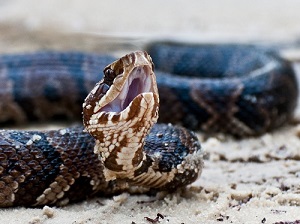Many workers perform tasks that bring them into environments where venomous snakes may be present, and without proper awareness, even routine outdoor work can become dangerous.

Snakes are naturally defensive animals, and most bites occur when a person accidentally surprises or threatens them. Workers in outdoor, rural, or heavily vegetated environments must know how to recognize risk areas, avoid unexpected encounters, and respond appropriately if a bite occurs.
Snakes may be found in tall grass, brush piles, debris, lumber stacks, water edges, abandoned structures, ditches, fields, or any location where they can hide and stay protected. Even non-venomous snakes can cause injury if startled, and venomous species pose a significantly higher risk.
The following types of jobs may expose individuals to snake hazards:
- Forestry
- Landscaping
- Tree trimming
- Groundskeeping
- Site clearing
- General housekeeping or maintenance
- Road construction
- Disaster response and cleanup work
OSHA Standard 1926.21(b)(4) requires that employees working in areas where harmful animals are present be trained on the hazards, how to avoid injury, and the correct first aid procedures in the event of an encounter or bite.
Understanding the local snake species and where they are commonly found is essential, and one snake that outdoor workers should be especially aware of is the cottonmouth.
Cottonmouth Snake Identification and Behavior
Cottonmouth snakes can be large, usually about 4–5 feet long. Adult cottonmouths have a dark tan, brown, or nearly black skin color, usually with black or dark brown crossbands. Younger cottonmouth snakes often have a more visible crossbanded pattern of brown or orange with a distinct yellow tail.
Cottonmouths are found in the Southeastern United States, commonly in or around water. Workers may encounter them in slow-moving or shallow lakes, streams, ponds, canals, marshes, drainage areas, or water-logged job sites.
The cottonmouth is venomous and can deliver a painful and potentially fatal bite. Unlike many snakes that quickly flee when approached, cottonmouths tend to stand their ground. When threatened, they may coil their bodies, open their mouths widely to display the white interior (the “cottonmouth”), and show their fangs as a warning.
Safety Precautions for Snake Encounters
When covering snake hazards during a safety meeting, workers should be reminded to:
- Watch where you place your hands and feet when removing debris, picking up materials, or conducting outdoor housekeeping.
- Wear heavy gloves when handling brush, leaves, lumber piles, or anything snakes might hide under.
- Consider wearing boots at least 10 inches high, especially when working in areas near water or dense vegetation.
- Remember that snakes generally bite only when threatened. If you see a snake, slowly step back and give it space to move away.
- Never attempt to kill, capture, or relocate a snake because doing so dramatically increases the chance of being bitten.
Responding to Snake Bites
If you or a co-worker is bitten by a snake on the job:
- Call 911 immediately. Treat every bite from an unknown snake as serious.
- Try to note the color, pattern, or head shape of the snake to help medical professionals identify treatment, or have someone safely take a photo if possible.
- Keep the bite victim calm and still to slow the spread of venom.
- Place the victim in a reclining position with the bite below heart level.
- Cover the wound lightly with a clean, dry dressing.
- NEVER cut the wound, apply ice, use a tourniquet, or attempt to suck out the venom because these outdated methods can worsen the injury.
With proper awareness, training, and precautions, workers can reduce the risk of dangerous encounters with venomous snakes such as cottonmouths. Clear communication during safety meetings, combined with site-specific training and good housekeeping practices, helps keep everyone safe when working outdoors in snake-prone environments.
.jpg)

.jpeg)